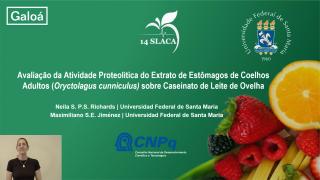Anais do Simpósio Latino Americano de Ciências de Alimentos
Actas del 14 SLACA - Simposio Latinoamericano de Ciencia de los Alimentos
ODOR-ACTIVE COMPOUNDS OF MERLOT WINE OF CAMPANHA GAÚCHA EVALUATED BY THE COMBINATION OF GC-O AND GCXGC/MS
¿Cómo citar este artículo?
To cite this paper use one of the standards below:
¿Cómo citar este artículo?
- Tipo de presentación: Pôster
- Eje temático: Ciencia de los alimentos y nutrición
- Palabras clave: aroma; Olfactometry; Red wines;
Autoras(es):
- 1 Universidade Federal do Rio Grande do Sul
- 2 Empresa Brasileira de Pesquisa Agropecuária
ODOR-ACTIVE COMPOUNDS OF MERLOT WINE OF CAMPANHA GAÚCHA EVALUATED BY THE COMBINATION OF GC-O AND GCXGC/MS
Karoline C. Hernandes
Universidade Federal do Rio Grande do Sul
Ahora podrías compartir conmigo tus preguntas, observaciones y felicitaciones.
Crea un tema- Tipo de presentación: Pôster
- Eje temático: Ciencia de los alimentos y nutrición
- Palabras clave: aroma; Olfactometry; Red wines;
Autoras(es):
- 1 Universidade Federal do Rio Grande do Sul
- 2 Empresa Brasileira de Pesquisa Agropecuária
Odor-active compounds contribute to wine quality and volatile compounds play an important role in the perception of these compounds. Gas chromatography coupled to mass spectrometry (GC/MS) is widely used in the evaluation of wine volatile profile. When gas chromatography is combined with olfactometry (GC-O) using the human nose as detector, data on odor-active compounds are obtained, allowing understanding the influence of these volatiles on a specific wine. However, wine is a complex matrix encompassing different compounds, which can result in coelutions when one-dimensional (1D-GC) is used. Comprehensive two-dimensional gas chromatography with mass spectrometry detection (GCxGC/MS) has allowed improvements in knowledge of wine. Merlot wines are among the most produced worldwide and the objective of this study was to identify the odor-active compounds of Merlot wine produced in Campanha Gaúcha region through the combination of GC-O Osme and GCxGC/MS. GCxGC/MS revealed the presence of 142 volatiles, including alcohols (34), esters (33), terpenes (26), acids (16), aldehydes (7), sulfur compounds (6), ketones (5), phenols (5), furan (4), lactones (4) and C13-norisoprenoids (2). GC-O allowed identifying of 24 odor-active compounds and GCxGC/MS indicated additional 14 odor-active compounds, which were found as coelutions. The role of the GCxGC/MS in elucidating compounds with distinct odor descriptions given by assessors during compound elution in GC-O was also verified. Among the coeluting compounds, hexanoic acid and geranyl acetone were separated using GCxGC/MS and the unpleasant and pungent odor mentioned in GC-O analysis was recognized to be related to the acid, while the floral odor of geranyl acetone has not been assigned. The use of GC-O-FID/MS procedure associated with GCxGC/MS provided a more in-depth evaluation of volatiles of a Merlot wine from Campanha Gaúcha.
Elogio
Amanda Mellissa B Oliveira
Parabéns a todos os autores pelo trabalho! E excelente apresentação! :)
- 1 respuesta
Optimice su evento académico
Con casi 200.000 artículos publicados, Galoá permite a los académicos compartir y descubrir investigaciones de vanguardia a través de nuestra plataforma de publicación académica optimizada y accesible.
Obtenga más información sobre nuestros productos:
¿Cómo citar este proceedings?
This proceedings is identified by a DOI , for use in citations or bibliographic references. Atención: este no es un DOI para el trabajo y, como tal, no se puede usar en Lattes para identificar un trabajo en particular.
Check the link "How to cite" en la página del papel, para ver cómo citar correctamente el papel



Juliane Elisa Welke
Obrigada!